The Role of Information Systems and Technology in Business
VerifiedAdded on 2023/01/12
|9
|2574
|30
Report
AI Summary
This report explores the critical role of information systems and technology in business management and expansion. It begins by emphasizing the importance of information systems in supporting various business functions and enabling data-driven decision-making. The report then delves into different types of information systems, including Transactional Processing Systems (TPS), Management Information Systems (MIS), Decision Support Systems (DSS), and Executive Information Systems (EIS), explaining their functions and hierarchical roles within an organization. A significant portion of the report is dedicated to Enterprise Resource Planning (ERP) systems, detailing their characteristics, benefits, and how they integrate various business processes. The example of Tesco is used to illustrate the practical advantages of ERP in gaining a competitive edge, improving efficiency, enhancing departmental collaboration, facilitating accurate forecasting, and providing a comprehensive view of business operations. The report concludes by summarizing the value of information systems and innovative technology in promoting business growth, effective resource utilization, and the ability to adapt to market changes.
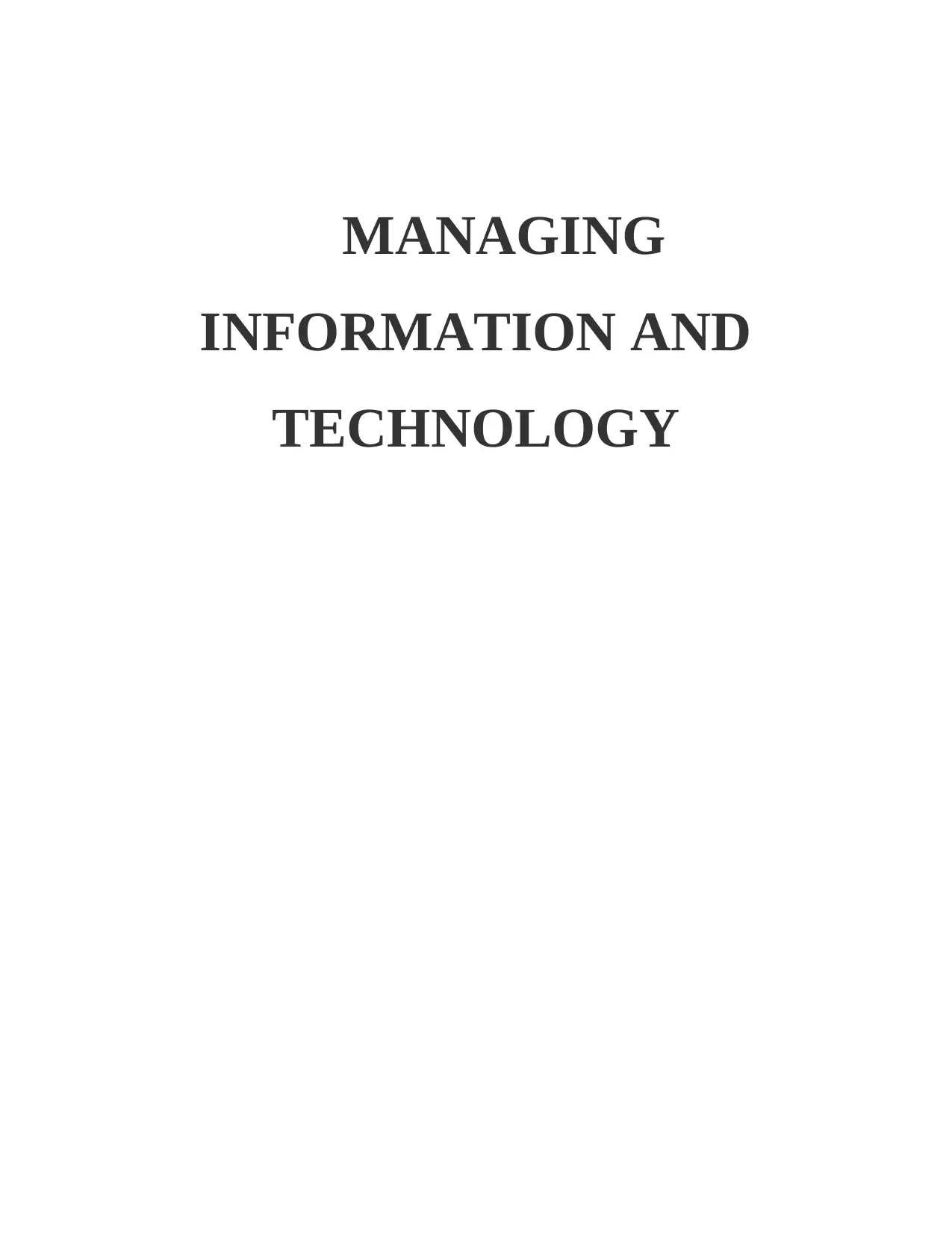
MANAGING
INFORMATION AND
TECHNOLOGY
INFORMATION AND
TECHNOLOGY
Paraphrase This Document
Need a fresh take? Get an instant paraphrase of this document with our AI Paraphraser
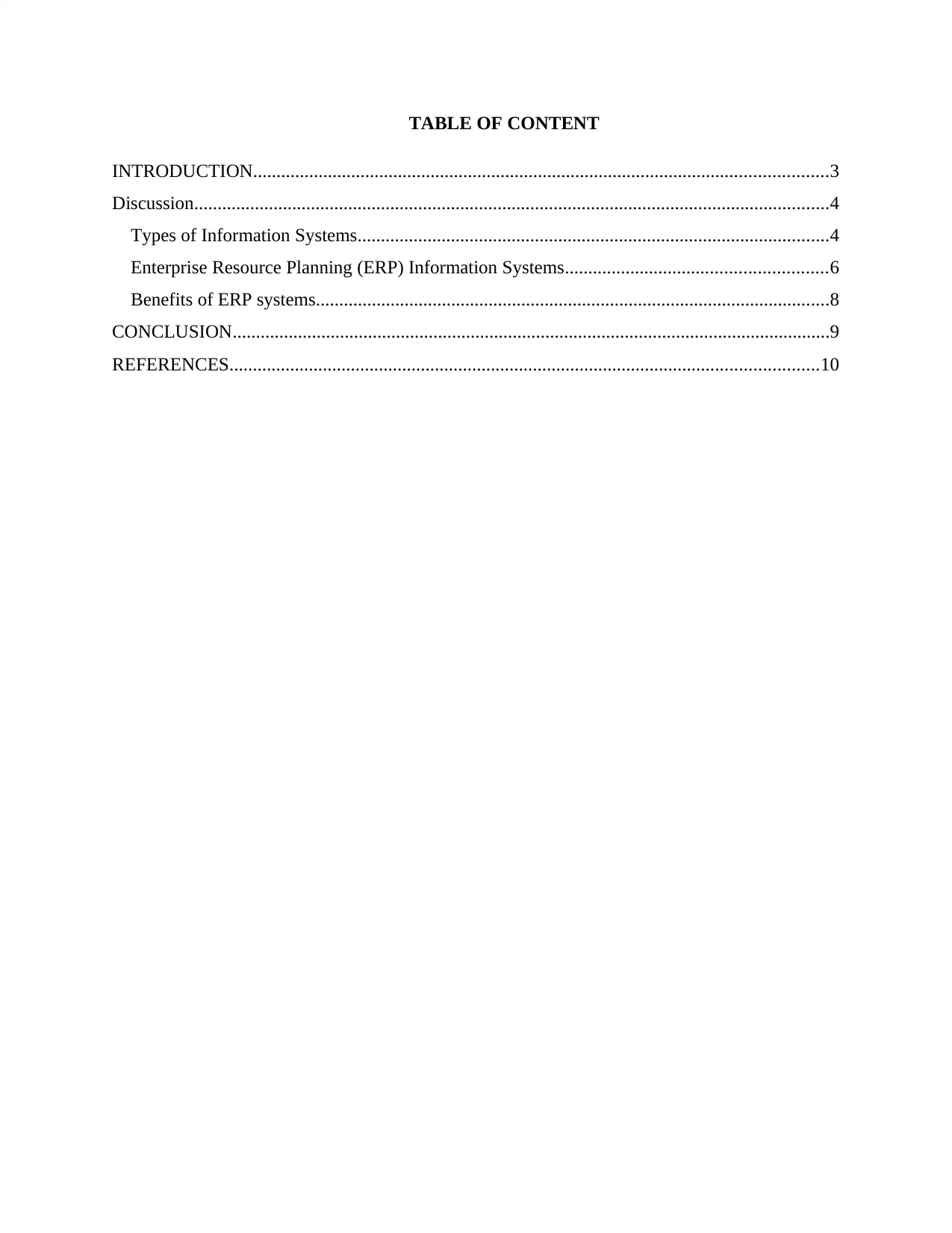
TABLE OF CONTENT
INTRODUCTION...........................................................................................................................3
Discussion........................................................................................................................................4
Types of Information Systems.....................................................................................................4
Enterprise Resource Planning (ERP) Information Systems........................................................6
Benefits of ERP systems..............................................................................................................8
CONCLUSION................................................................................................................................9
REFERENCES..............................................................................................................................10
INTRODUCTION...........................................................................................................................3
Discussion........................................................................................................................................4
Types of Information Systems.....................................................................................................4
Enterprise Resource Planning (ERP) Information Systems........................................................6
Benefits of ERP systems..............................................................................................................8
CONCLUSION................................................................................................................................9
REFERENCES..............................................................................................................................10
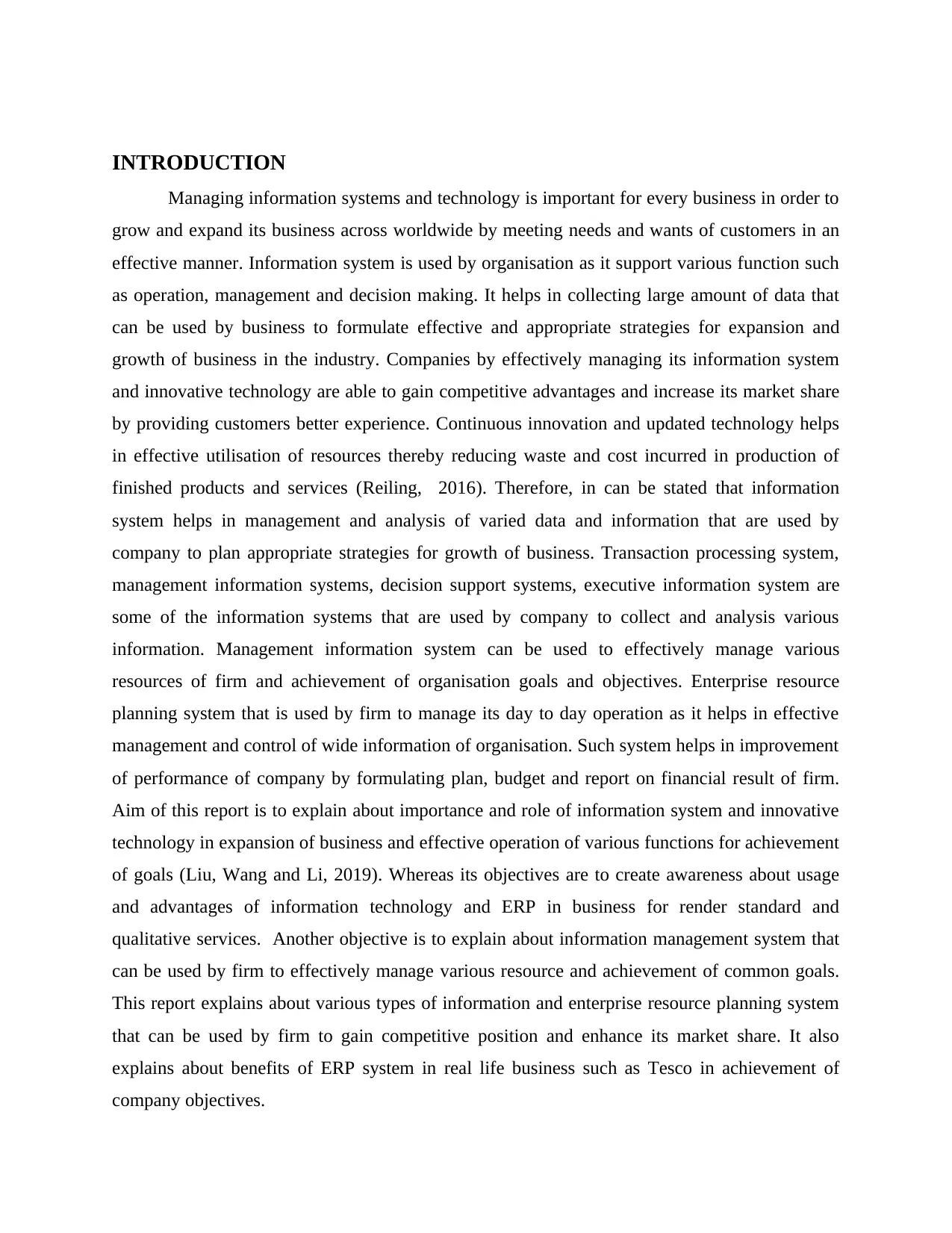
INTRODUCTION
Managing information systems and technology is important for every business in order to
grow and expand its business across worldwide by meeting needs and wants of customers in an
effective manner. Information system is used by organisation as it support various function such
as operation, management and decision making. It helps in collecting large amount of data that
can be used by business to formulate effective and appropriate strategies for expansion and
growth of business in the industry. Companies by effectively managing its information system
and innovative technology are able to gain competitive advantages and increase its market share
by providing customers better experience. Continuous innovation and updated technology helps
in effective utilisation of resources thereby reducing waste and cost incurred in production of
finished products and services (Reiling, 2016). Therefore, in can be stated that information
system helps in management and analysis of varied data and information that are used by
company to plan appropriate strategies for growth of business. Transaction processing system,
management information systems, decision support systems, executive information system are
some of the information systems that are used by company to collect and analysis various
information. Management information system can be used to effectively manage various
resources of firm and achievement of organisation goals and objectives. Enterprise resource
planning system that is used by firm to manage its day to day operation as it helps in effective
management and control of wide information of organisation. Such system helps in improvement
of performance of company by formulating plan, budget and report on financial result of firm.
Aim of this report is to explain about importance and role of information system and innovative
technology in expansion of business and effective operation of various functions for achievement
of goals (Liu, Wang and Li, 2019). Whereas its objectives are to create awareness about usage
and advantages of information technology and ERP in business for render standard and
qualitative services. Another objective is to explain about information management system that
can be used by firm to effectively manage various resource and achievement of common goals.
This report explains about various types of information and enterprise resource planning system
that can be used by firm to gain competitive position and enhance its market share. It also
explains about benefits of ERP system in real life business such as Tesco in achievement of
company objectives.
Managing information systems and technology is important for every business in order to
grow and expand its business across worldwide by meeting needs and wants of customers in an
effective manner. Information system is used by organisation as it support various function such
as operation, management and decision making. It helps in collecting large amount of data that
can be used by business to formulate effective and appropriate strategies for expansion and
growth of business in the industry. Companies by effectively managing its information system
and innovative technology are able to gain competitive advantages and increase its market share
by providing customers better experience. Continuous innovation and updated technology helps
in effective utilisation of resources thereby reducing waste and cost incurred in production of
finished products and services (Reiling, 2016). Therefore, in can be stated that information
system helps in management and analysis of varied data and information that are used by
company to plan appropriate strategies for growth of business. Transaction processing system,
management information systems, decision support systems, executive information system are
some of the information systems that are used by company to collect and analysis various
information. Management information system can be used to effectively manage various
resources of firm and achievement of organisation goals and objectives. Enterprise resource
planning system that is used by firm to manage its day to day operation as it helps in effective
management and control of wide information of organisation. Such system helps in improvement
of performance of company by formulating plan, budget and report on financial result of firm.
Aim of this report is to explain about importance and role of information system and innovative
technology in expansion of business and effective operation of various functions for achievement
of goals (Liu, Wang and Li, 2019). Whereas its objectives are to create awareness about usage
and advantages of information technology and ERP in business for render standard and
qualitative services. Another objective is to explain about information management system that
can be used by firm to effectively manage various resource and achievement of common goals.
This report explains about various types of information and enterprise resource planning system
that can be used by firm to gain competitive position and enhance its market share. It also
explains about benefits of ERP system in real life business such as Tesco in achievement of
company objectives.
⊘ This is a preview!⊘
Do you want full access?
Subscribe today to unlock all pages.

Trusted by 1+ million students worldwide
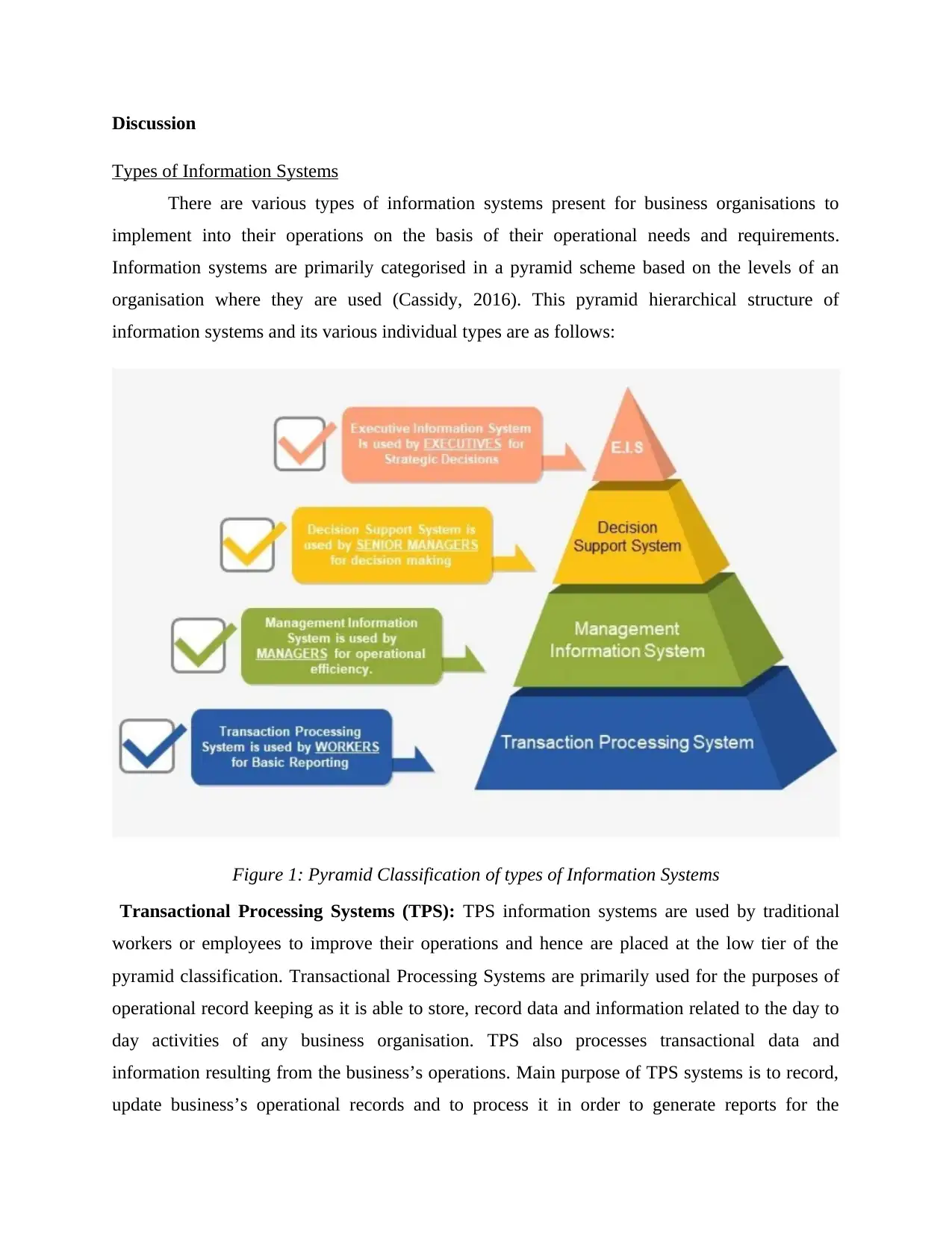
Discussion
Types of Information Systems
There are various types of information systems present for business organisations to
implement into their operations on the basis of their operational needs and requirements.
Information systems are primarily categorised in a pyramid scheme based on the levels of an
organisation where they are used (Cassidy, 2016). This pyramid hierarchical structure of
information systems and its various individual types are as follows:
Figure 1: Pyramid Classification of types of Information Systems
Transactional Processing Systems (TPS): TPS information systems are used by traditional
workers or employees to improve their operations and hence are placed at the low tier of the
pyramid classification. Transactional Processing Systems are primarily used for the purposes of
operational record keeping as it is able to store, record data and information related to the day to
day activities of any business organisation. TPS also processes transactional data and
information resulting from the business’s operations. Main purpose of TPS systems is to record,
update business’s operational records and to process it in order to generate reports for the
Types of Information Systems
There are various types of information systems present for business organisations to
implement into their operations on the basis of their operational needs and requirements.
Information systems are primarily categorised in a pyramid scheme based on the levels of an
organisation where they are used (Cassidy, 2016). This pyramid hierarchical structure of
information systems and its various individual types are as follows:
Figure 1: Pyramid Classification of types of Information Systems
Transactional Processing Systems (TPS): TPS information systems are used by traditional
workers or employees to improve their operations and hence are placed at the low tier of the
pyramid classification. Transactional Processing Systems are primarily used for the purposes of
operational record keeping as it is able to store, record data and information related to the day to
day activities of any business organisation. TPS also processes transactional data and
information resulting from the business’s operations. Main purpose of TPS systems is to record,
update business’s operational records and to process it in order to generate reports for the
Paraphrase This Document
Need a fresh take? Get an instant paraphrase of this document with our AI Paraphraser
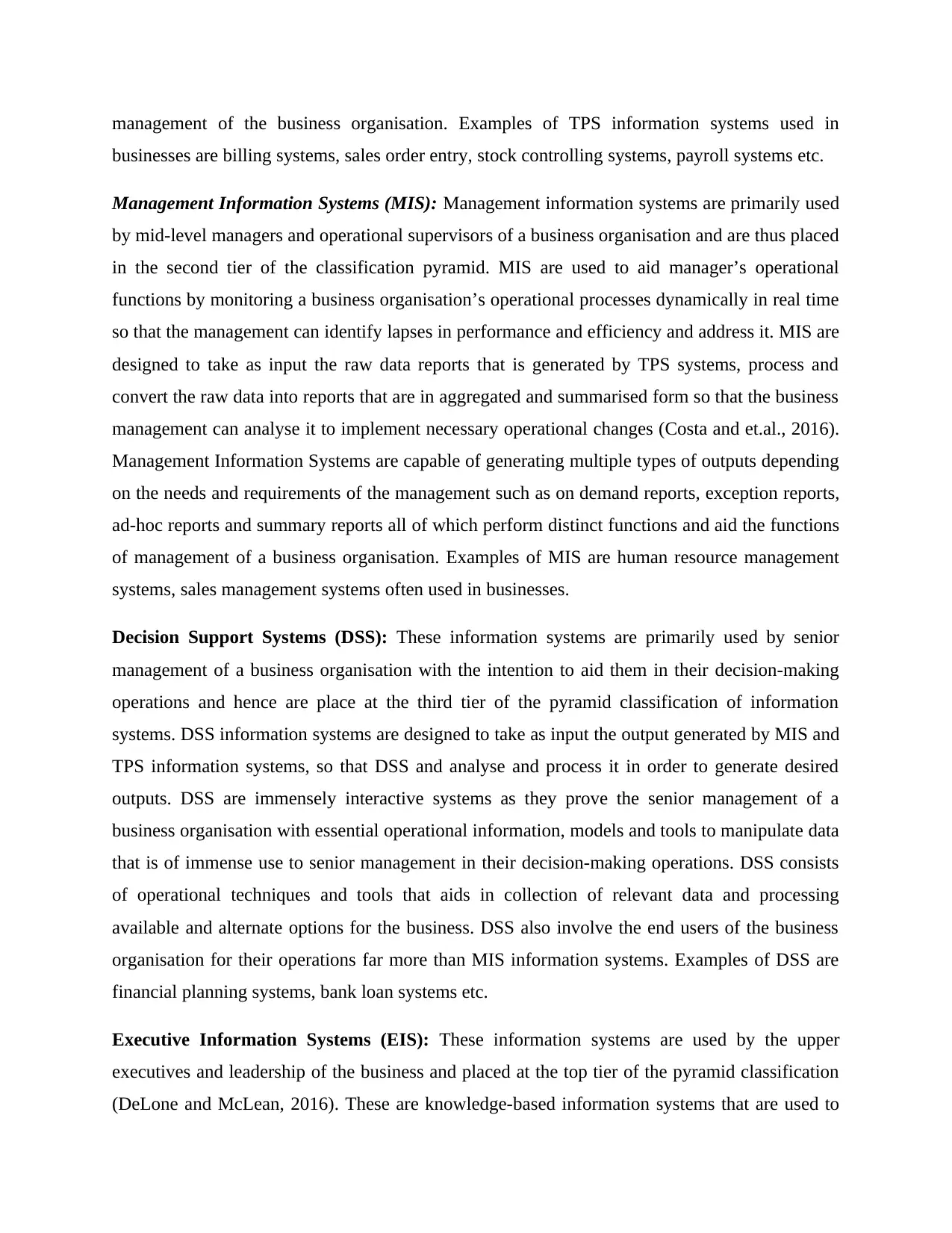
management of the business organisation. Examples of TPS information systems used in
businesses are billing systems, sales order entry, stock controlling systems, payroll systems etc.
Management Information Systems (MIS): Management information systems are primarily used
by mid-level managers and operational supervisors of a business organisation and are thus placed
in the second tier of the classification pyramid. MIS are used to aid manager’s operational
functions by monitoring a business organisation’s operational processes dynamically in real time
so that the management can identify lapses in performance and efficiency and address it. MIS are
designed to take as input the raw data reports that is generated by TPS systems, process and
convert the raw data into reports that are in aggregated and summarised form so that the business
management can analyse it to implement necessary operational changes (Costa and et.al., 2016).
Management Information Systems are capable of generating multiple types of outputs depending
on the needs and requirements of the management such as on demand reports, exception reports,
ad-hoc reports and summary reports all of which perform distinct functions and aid the functions
of management of a business organisation. Examples of MIS are human resource management
systems, sales management systems often used in businesses.
Decision Support Systems (DSS): These information systems are primarily used by senior
management of a business organisation with the intention to aid them in their decision-making
operations and hence are place at the third tier of the pyramid classification of information
systems. DSS information systems are designed to take as input the output generated by MIS and
TPS information systems, so that DSS and analyse and process it in order to generate desired
outputs. DSS are immensely interactive systems as they prove the senior management of a
business organisation with essential operational information, models and tools to manipulate data
that is of immense use to senior management in their decision-making operations. DSS consists
of operational techniques and tools that aids in collection of relevant data and processing
available and alternate options for the business. DSS also involve the end users of the business
organisation for their operations far more than MIS information systems. Examples of DSS are
financial planning systems, bank loan systems etc.
Executive Information Systems (EIS): These information systems are used by the upper
executives and leadership of the business and placed at the top tier of the pyramid classification
(DeLone and McLean, 2016). These are knowledge-based information systems that are used to
businesses are billing systems, sales order entry, stock controlling systems, payroll systems etc.
Management Information Systems (MIS): Management information systems are primarily used
by mid-level managers and operational supervisors of a business organisation and are thus placed
in the second tier of the classification pyramid. MIS are used to aid manager’s operational
functions by monitoring a business organisation’s operational processes dynamically in real time
so that the management can identify lapses in performance and efficiency and address it. MIS are
designed to take as input the raw data reports that is generated by TPS systems, process and
convert the raw data into reports that are in aggregated and summarised form so that the business
management can analyse it to implement necessary operational changes (Costa and et.al., 2016).
Management Information Systems are capable of generating multiple types of outputs depending
on the needs and requirements of the management such as on demand reports, exception reports,
ad-hoc reports and summary reports all of which perform distinct functions and aid the functions
of management of a business organisation. Examples of MIS are human resource management
systems, sales management systems often used in businesses.
Decision Support Systems (DSS): These information systems are primarily used by senior
management of a business organisation with the intention to aid them in their decision-making
operations and hence are place at the third tier of the pyramid classification of information
systems. DSS information systems are designed to take as input the output generated by MIS and
TPS information systems, so that DSS and analyse and process it in order to generate desired
outputs. DSS are immensely interactive systems as they prove the senior management of a
business organisation with essential operational information, models and tools to manipulate data
that is of immense use to senior management in their decision-making operations. DSS consists
of operational techniques and tools that aids in collection of relevant data and processing
available and alternate options for the business. DSS also involve the end users of the business
organisation for their operations far more than MIS information systems. Examples of DSS are
financial planning systems, bank loan systems etc.
Executive Information Systems (EIS): These information systems are used by the upper
executives and leadership of the business and placed at the top tier of the pyramid classification
(DeLone and McLean, 2016). These are knowledge-based information systems that are used to
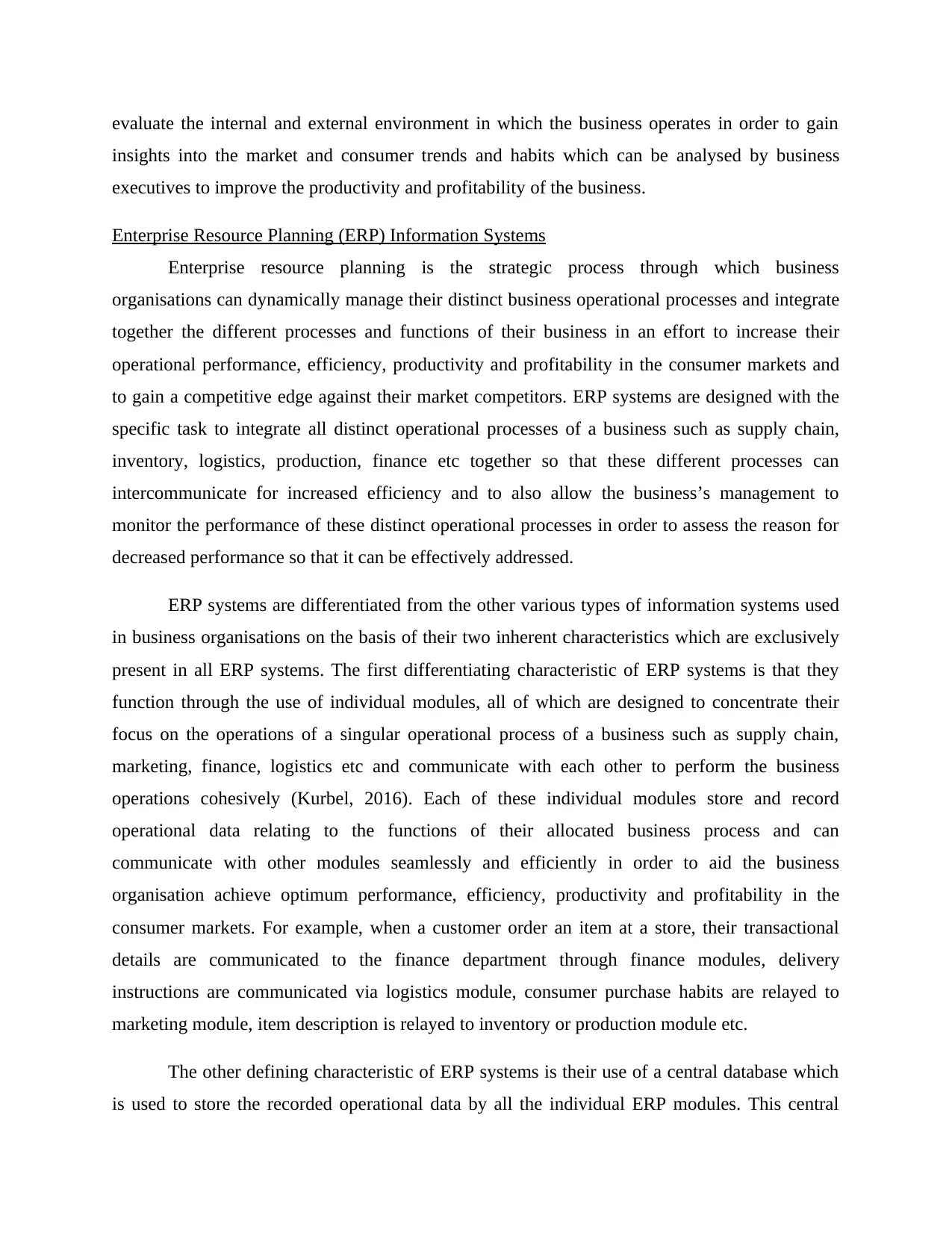
evaluate the internal and external environment in which the business operates in order to gain
insights into the market and consumer trends and habits which can be analysed by business
executives to improve the productivity and profitability of the business.
Enterprise Resource Planning (ERP) Information Systems
Enterprise resource planning is the strategic process through which business
organisations can dynamically manage their distinct business operational processes and integrate
together the different processes and functions of their business in an effort to increase their
operational performance, efficiency, productivity and profitability in the consumer markets and
to gain a competitive edge against their market competitors. ERP systems are designed with the
specific task to integrate all distinct operational processes of a business such as supply chain,
inventory, logistics, production, finance etc together so that these different processes can
intercommunicate for increased efficiency and to also allow the business’s management to
monitor the performance of these distinct operational processes in order to assess the reason for
decreased performance so that it can be effectively addressed.
ERP systems are differentiated from the other various types of information systems used
in business organisations on the basis of their two inherent characteristics which are exclusively
present in all ERP systems. The first differentiating characteristic of ERP systems is that they
function through the use of individual modules, all of which are designed to concentrate their
focus on the operations of a singular operational process of a business such as supply chain,
marketing, finance, logistics etc and communicate with each other to perform the business
operations cohesively (Kurbel, 2016). Each of these individual modules store and record
operational data relating to the functions of their allocated business process and can
communicate with other modules seamlessly and efficiently in order to aid the business
organisation achieve optimum performance, efficiency, productivity and profitability in the
consumer markets. For example, when a customer order an item at a store, their transactional
details are communicated to the finance department through finance modules, delivery
instructions are communicated via logistics module, consumer purchase habits are relayed to
marketing module, item description is relayed to inventory or production module etc.
The other defining characteristic of ERP systems is their use of a central database which
is used to store the recorded operational data by all the individual ERP modules. This central
insights into the market and consumer trends and habits which can be analysed by business
executives to improve the productivity and profitability of the business.
Enterprise Resource Planning (ERP) Information Systems
Enterprise resource planning is the strategic process through which business
organisations can dynamically manage their distinct business operational processes and integrate
together the different processes and functions of their business in an effort to increase their
operational performance, efficiency, productivity and profitability in the consumer markets and
to gain a competitive edge against their market competitors. ERP systems are designed with the
specific task to integrate all distinct operational processes of a business such as supply chain,
inventory, logistics, production, finance etc together so that these different processes can
intercommunicate for increased efficiency and to also allow the business’s management to
monitor the performance of these distinct operational processes in order to assess the reason for
decreased performance so that it can be effectively addressed.
ERP systems are differentiated from the other various types of information systems used
in business organisations on the basis of their two inherent characteristics which are exclusively
present in all ERP systems. The first differentiating characteristic of ERP systems is that they
function through the use of individual modules, all of which are designed to concentrate their
focus on the operations of a singular operational process of a business such as supply chain,
marketing, finance, logistics etc and communicate with each other to perform the business
operations cohesively (Kurbel, 2016). Each of these individual modules store and record
operational data relating to the functions of their allocated business process and can
communicate with other modules seamlessly and efficiently in order to aid the business
organisation achieve optimum performance, efficiency, productivity and profitability in the
consumer markets. For example, when a customer order an item at a store, their transactional
details are communicated to the finance department through finance modules, delivery
instructions are communicated via logistics module, consumer purchase habits are relayed to
marketing module, item description is relayed to inventory or production module etc.
The other defining characteristic of ERP systems is their use of a central database which
is used to store the recorded operational data by all the individual ERP modules. This central
⊘ This is a preview!⊘
Do you want full access?
Subscribe today to unlock all pages.

Trusted by 1+ million students worldwide
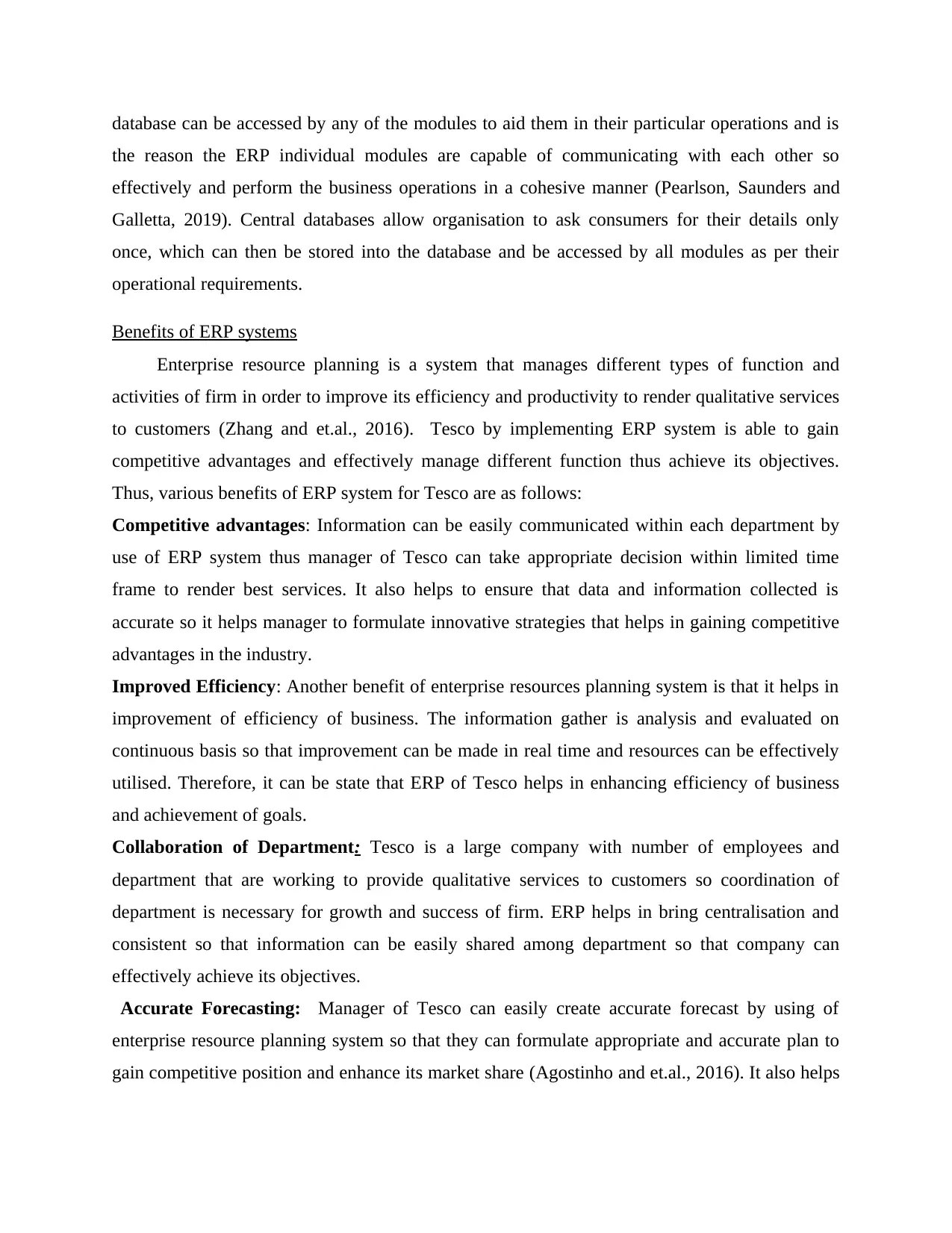
database can be accessed by any of the modules to aid them in their particular operations and is
the reason the ERP individual modules are capable of communicating with each other so
effectively and perform the business operations in a cohesive manner (Pearlson, Saunders and
Galletta, 2019). Central databases allow organisation to ask consumers for their details only
once, which can then be stored into the database and be accessed by all modules as per their
operational requirements.
Benefits of ERP systems
Enterprise resource planning is a system that manages different types of function and
activities of firm in order to improve its efficiency and productivity to render qualitative services
to customers (Zhang and et.al., 2016). Tesco by implementing ERP system is able to gain
competitive advantages and effectively manage different function thus achieve its objectives.
Thus, various benefits of ERP system for Tesco are as follows:
Competitive advantages: Information can be easily communicated within each department by
use of ERP system thus manager of Tesco can take appropriate decision within limited time
frame to render best services. It also helps to ensure that data and information collected is
accurate so it helps manager to formulate innovative strategies that helps in gaining competitive
advantages in the industry.
Improved Efficiency: Another benefit of enterprise resources planning system is that it helps in
improvement of efficiency of business. The information gather is analysis and evaluated on
continuous basis so that improvement can be made in real time and resources can be effectively
utilised. Therefore, it can be state that ERP of Tesco helps in enhancing efficiency of business
and achievement of goals.
Collaboration of Department: Tesco is a large company with number of employees and
department that are working to provide qualitative services to customers so coordination of
department is necessary for growth and success of firm. ERP helps in bring centralisation and
consistent so that information can be easily shared among department so that company can
effectively achieve its objectives.
Accurate Forecasting: Manager of Tesco can easily create accurate forecast by using of
enterprise resource planning system so that they can formulate appropriate and accurate plan to
gain competitive position and enhance its market share (Agostinho and et.al., 2016). It also helps
the reason the ERP individual modules are capable of communicating with each other so
effectively and perform the business operations in a cohesive manner (Pearlson, Saunders and
Galletta, 2019). Central databases allow organisation to ask consumers for their details only
once, which can then be stored into the database and be accessed by all modules as per their
operational requirements.
Benefits of ERP systems
Enterprise resource planning is a system that manages different types of function and
activities of firm in order to improve its efficiency and productivity to render qualitative services
to customers (Zhang and et.al., 2016). Tesco by implementing ERP system is able to gain
competitive advantages and effectively manage different function thus achieve its objectives.
Thus, various benefits of ERP system for Tesco are as follows:
Competitive advantages: Information can be easily communicated within each department by
use of ERP system thus manager of Tesco can take appropriate decision within limited time
frame to render best services. It also helps to ensure that data and information collected is
accurate so it helps manager to formulate innovative strategies that helps in gaining competitive
advantages in the industry.
Improved Efficiency: Another benefit of enterprise resources planning system is that it helps in
improvement of efficiency of business. The information gather is analysis and evaluated on
continuous basis so that improvement can be made in real time and resources can be effectively
utilised. Therefore, it can be state that ERP of Tesco helps in enhancing efficiency of business
and achievement of goals.
Collaboration of Department: Tesco is a large company with number of employees and
department that are working to provide qualitative services to customers so coordination of
department is necessary for growth and success of firm. ERP helps in bring centralisation and
consistent so that information can be easily shared among department so that company can
effectively achieve its objectives.
Accurate Forecasting: Manager of Tesco can easily create accurate forecast by using of
enterprise resource planning system so that they can formulate appropriate and accurate plan to
gain competitive position and enhance its market share (Agostinho and et.al., 2016). It also helps
Paraphrase This Document
Need a fresh take? Get an instant paraphrase of this document with our AI Paraphraser
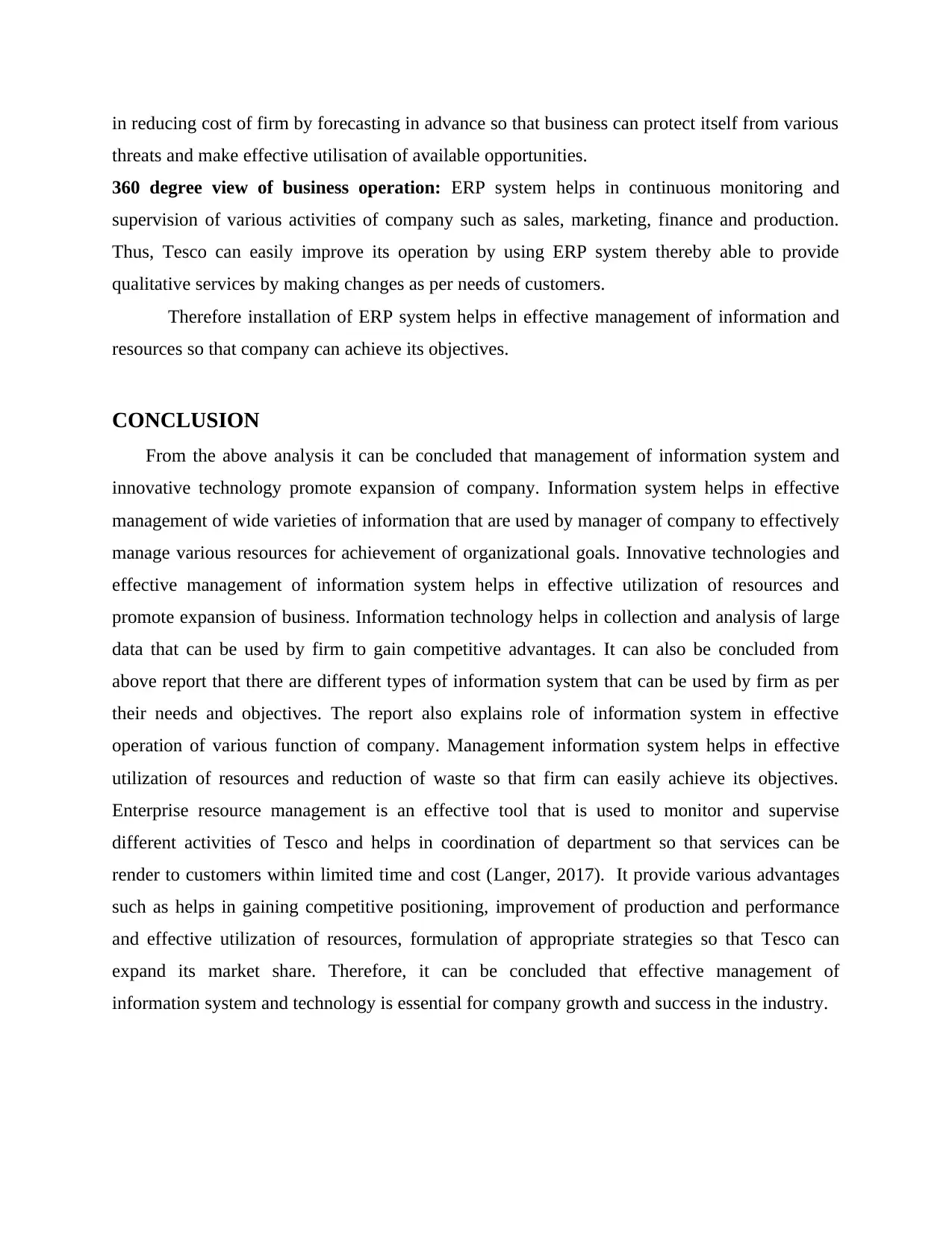
in reducing cost of firm by forecasting in advance so that business can protect itself from various
threats and make effective utilisation of available opportunities.
360 degree view of business operation: ERP system helps in continuous monitoring and
supervision of various activities of company such as sales, marketing, finance and production.
Thus, Tesco can easily improve its operation by using ERP system thereby able to provide
qualitative services by making changes as per needs of customers.
Therefore installation of ERP system helps in effective management of information and
resources so that company can achieve its objectives.
CONCLUSION
From the above analysis it can be concluded that management of information system and
innovative technology promote expansion of company. Information system helps in effective
management of wide varieties of information that are used by manager of company to effectively
manage various resources for achievement of organizational goals. Innovative technologies and
effective management of information system helps in effective utilization of resources and
promote expansion of business. Information technology helps in collection and analysis of large
data that can be used by firm to gain competitive advantages. It can also be concluded from
above report that there are different types of information system that can be used by firm as per
their needs and objectives. The report also explains role of information system in effective
operation of various function of company. Management information system helps in effective
utilization of resources and reduction of waste so that firm can easily achieve its objectives.
Enterprise resource management is an effective tool that is used to monitor and supervise
different activities of Tesco and helps in coordination of department so that services can be
render to customers within limited time and cost (Langer, 2017). It provide various advantages
such as helps in gaining competitive positioning, improvement of production and performance
and effective utilization of resources, formulation of appropriate strategies so that Tesco can
expand its market share. Therefore, it can be concluded that effective management of
information system and technology is essential for company growth and success in the industry.
threats and make effective utilisation of available opportunities.
360 degree view of business operation: ERP system helps in continuous monitoring and
supervision of various activities of company such as sales, marketing, finance and production.
Thus, Tesco can easily improve its operation by using ERP system thereby able to provide
qualitative services by making changes as per needs of customers.
Therefore installation of ERP system helps in effective management of information and
resources so that company can achieve its objectives.
CONCLUSION
From the above analysis it can be concluded that management of information system and
innovative technology promote expansion of company. Information system helps in effective
management of wide varieties of information that are used by manager of company to effectively
manage various resources for achievement of organizational goals. Innovative technologies and
effective management of information system helps in effective utilization of resources and
promote expansion of business. Information technology helps in collection and analysis of large
data that can be used by firm to gain competitive advantages. It can also be concluded from
above report that there are different types of information system that can be used by firm as per
their needs and objectives. The report also explains role of information system in effective
operation of various function of company. Management information system helps in effective
utilization of resources and reduction of waste so that firm can easily achieve its objectives.
Enterprise resource management is an effective tool that is used to monitor and supervise
different activities of Tesco and helps in coordination of department so that services can be
render to customers within limited time and cost (Langer, 2017). It provide various advantages
such as helps in gaining competitive positioning, improvement of production and performance
and effective utilization of resources, formulation of appropriate strategies so that Tesco can
expand its market share. Therefore, it can be concluded that effective management of
information system and technology is essential for company growth and success in the industry.
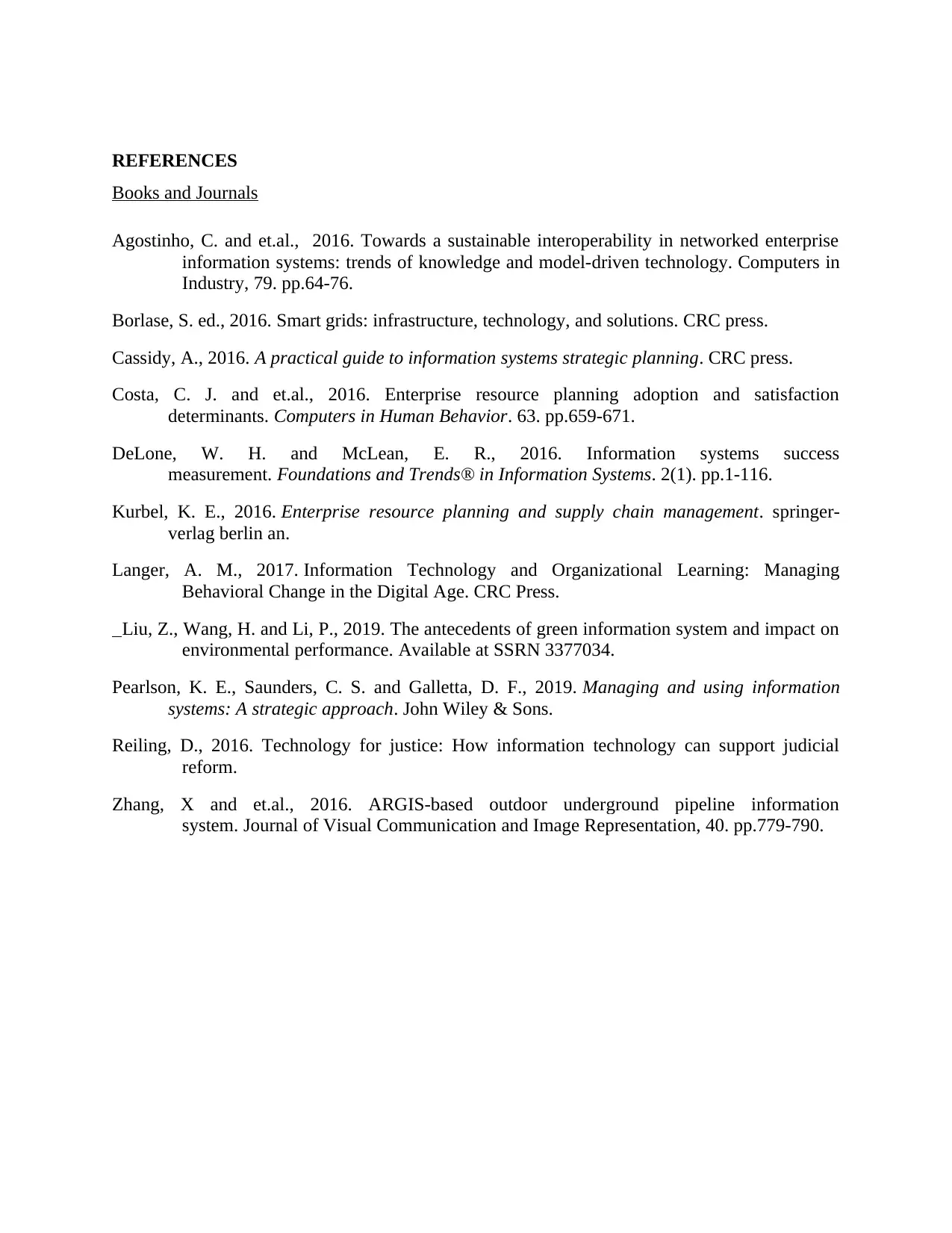
REFERENCES
Books and Journals
Agostinho, C. and et.al., 2016. Towards a sustainable interoperability in networked enterprise
information systems: trends of knowledge and model-driven technology. Computers in
Industry, 79. pp.64-76.
Borlase, S. ed., 2016. Smart grids: infrastructure, technology, and solutions. CRC press.
Cassidy, A., 2016. A practical guide to information systems strategic planning. CRC press.
Costa, C. J. and et.al., 2016. Enterprise resource planning adoption and satisfaction
determinants. Computers in Human Behavior. 63. pp.659-671.
DeLone, W. H. and McLean, E. R., 2016. Information systems success
measurement. Foundations and Trends® in Information Systems. 2(1). pp.1-116.
Kurbel, K. E., 2016. Enterprise resource planning and supply chain management. springer-
verlag berlin an.
Langer, A. M., 2017. Information Technology and Organizational Learning: Managing
Behavioral Change in the Digital Age. CRC Press.
Liu, Z., Wang, H. and Li, P., 2019. The antecedents of green information system and impact on
environmental performance. Available at SSRN 3377034.
Pearlson, K. E., Saunders, C. S. and Galletta, D. F., 2019. Managing and using information
systems: A strategic approach. John Wiley & Sons.
Reiling, D., 2016. Technology for justice: How information technology can support judicial
reform.
Zhang, X and et.al., 2016. ARGIS-based outdoor underground pipeline information
system. Journal of Visual Communication and Image Representation, 40. pp.779-790.
Books and Journals
Agostinho, C. and et.al., 2016. Towards a sustainable interoperability in networked enterprise
information systems: trends of knowledge and model-driven technology. Computers in
Industry, 79. pp.64-76.
Borlase, S. ed., 2016. Smart grids: infrastructure, technology, and solutions. CRC press.
Cassidy, A., 2016. A practical guide to information systems strategic planning. CRC press.
Costa, C. J. and et.al., 2016. Enterprise resource planning adoption and satisfaction
determinants. Computers in Human Behavior. 63. pp.659-671.
DeLone, W. H. and McLean, E. R., 2016. Information systems success
measurement. Foundations and Trends® in Information Systems. 2(1). pp.1-116.
Kurbel, K. E., 2016. Enterprise resource planning and supply chain management. springer-
verlag berlin an.
Langer, A. M., 2017. Information Technology and Organizational Learning: Managing
Behavioral Change in the Digital Age. CRC Press.
Liu, Z., Wang, H. and Li, P., 2019. The antecedents of green information system and impact on
environmental performance. Available at SSRN 3377034.
Pearlson, K. E., Saunders, C. S. and Galletta, D. F., 2019. Managing and using information
systems: A strategic approach. John Wiley & Sons.
Reiling, D., 2016. Technology for justice: How information technology can support judicial
reform.
Zhang, X and et.al., 2016. ARGIS-based outdoor underground pipeline information
system. Journal of Visual Communication and Image Representation, 40. pp.779-790.
⊘ This is a preview!⊘
Do you want full access?
Subscribe today to unlock all pages.

Trusted by 1+ million students worldwide
1 out of 9
Related Documents
Your All-in-One AI-Powered Toolkit for Academic Success.
+13062052269
info@desklib.com
Available 24*7 on WhatsApp / Email
![[object Object]](/_next/static/media/star-bottom.7253800d.svg)
Unlock your academic potential
Copyright © 2020–2025 A2Z Services. All Rights Reserved. Developed and managed by ZUCOL.




